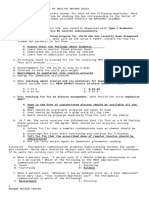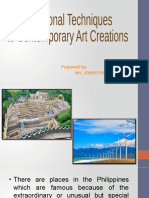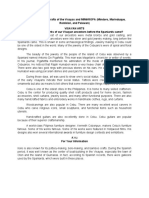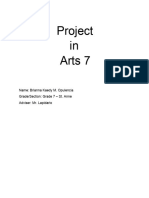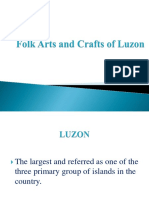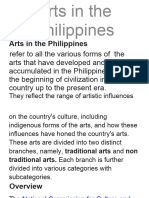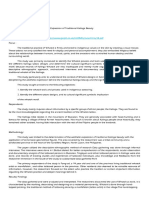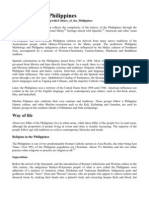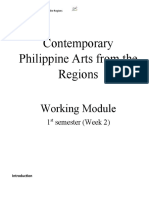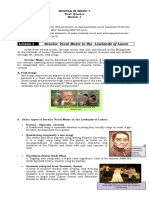0 ratings0% found this document useful (0 votes)
16 viewsModule 9
Uploaded by
dianaeleriaCopyright
© © All Rights Reserved
Available Formats
Download as PDF, TXT or read online on Scribd
0 ratings0% found this document useful (0 votes)
16 viewsModule 9
Uploaded by
dianaeleriaCopyright
© © All Rights Reserved
Available Formats
Download as PDF, TXT or read online on Scribd
You are on page 1/ 11
Arts in Cordillera
Region and Muslim
South
CORDILLERA
REGION
Tribal Art:
• The Cordillera region is home to various indigenous tribes
such as the Ifugao, Kalinga, Bontoc, and more. These
tribes have a long history of creating intricate
woodcarvings, textiles, and metalwork. Among the most
famous are the Ifugao rice terraces, a UNESCO World
Heritage Site, known for their engineering marvel and
cultural significance.
Whang-od Oggay, also known
as Maria Oggay, is a tattoo
artist from the village of
Buscalan within Tinglayan,
Kalinga, Philippines. She is
often described as the "last"
and oldest mambabatok and
is part of the Butbut people of
the larger Kalinga ethnic
Weaving:
• Handwoven textiles play a significant role in the culture
of the Cordillera tribes. Each tribe has its distinctive
weaving patterns, motifs, and techniques. The fabrics are
often used for traditional clothing, accessories, and
ceremonial purposes.
Woodcarving:
• Cordilleran woodcarvers are highly skilled artisans
known for creating various items such as bululs (rice
gods), sculptures, and functional objects like rice wine
containers and utensils. The intricate carvings often depict
elements from nature, folklore, and tribal symbols.
The bulol, or "Ifugao rice god," is a
carved human figurine into which a
certain class of anito is said to
incorporate itself when worshipped.
Bulols are kept in the house or
granary, and are usually made in
pairs. They are carved of narra
wood, which represents wealth,
Music and Dance:
Traditional music and dance are integral to
Cordilleran culture. Instruments like the
gangsa (a type of gong), bamboo percussion
instruments, and indigenous string
instruments accompany lively dances
performed during festivals, rituals, and
celebrations.
MUSLIM SOUTH
Islamic
Calligraphy:
Calligraphy holds a special place in Islamic art and culture. In
the southern Philippines, Muslim artists create stunning
calligraphic artworks using Arabic script, often featuring verses
from the Quran or Islamic poetry. Calligraphy can be found
adorning mosques, homes, and other Islamic spaces.
Batik and Malong
Batik is a traditional fabric dyeing technique
popular in Muslim communities in the
southern Philippines. The resulting colorful
textiles are used to make garments like sarongs
and headscarves. Malong, a tube-like garment,
is also widely worn in the region, showcasing
vibrant patterns and designs.
Okir
Okir is a distinctive Islamic art form
characterized by intricate geometric and
floral designs. It is commonly seen in
woodcarvings, especially in the decoration of
mosques, homes, and traditional furniture.
Music and Dance:
Music and dance are essential components of
Muslim culture in the southern Philippines.
Traditional instruments like the kulintang (a set
of gongs), agong (large hanging gong), and
tambul (drum) accompany various dances
performed during weddings, festivals, and
religious events.
You might also like
- Arts in The Cordillera Region and Muslim South (Autosaved)100% (4)Arts in The Cordillera Region and Muslim South (Autosaved)22 pages
- Arts in The Cordillera Region and Muslim South (Autosaved) NNN100% (7)Arts in The Cordillera Region and Muslim South (Autosaved) NNN22 pages
- Philippine Indigenous People Culture and Practices: - Prof. Sheryl B. SalazarNo ratings yetPhilippine Indigenous People Culture and Practices: - Prof. Sheryl B. Salazar19 pages
- Indigenous-Traditions-and-Transformations-in-Philippine-Visual-ArtsNo ratings yetIndigenous-Traditions-and-Transformations-in-Philippine-Visual-Arts41 pages
- Lesson 13 Philippine Traditional Motifs and CraftsNo ratings yetLesson 13 Philippine Traditional Motifs and Crafts34 pages
- Lesson 13 Philippine Traditional Motifs and CraftsNo ratings yetLesson 13 Philippine Traditional Motifs and Crafts34 pages
- Philippineindigenousarts 100721200107 Phpapp01No ratings yetPhilippineindigenousarts 100721200107 Phpapp0136 pages
- Bsab 1m-2 Group 1 Indiginous Creative CraftsNo ratings yetBsab 1m-2 Group 1 Indiginous Creative Crafts28 pages
- Philippine Indigenous Arts: Prepared By: Ms. Rosalia C. Rosario100% (1)Philippine Indigenous Arts: Prepared By: Ms. Rosalia C. Rosario36 pages
- Q2 Arts 7 Lesson 1 Arts and Crats of Mimaropa & VisayasNo ratings yetQ2 Arts 7 Lesson 1 Arts and Crats of Mimaropa & Visayas48 pages
- LESSON 12. Indigenous Peoples Art in The RegionNo ratings yetLESSON 12. Indigenous Peoples Art in The Region35 pages
- Q1 Arts Supplemental Reading Material - Highlands of Luzon - PDFNo ratings yetQ1 Arts Supplemental Reading Material - Highlands of Luzon - PDF4 pages
- Good Morning 4-Visionary Mr. Eljohn O. Cabantac ArtsNo ratings yetGood Morning 4-Visionary Mr. Eljohn O. Cabantac Arts34 pages
- A Brief History of Philippine Visual Arts PDFNo ratings yetA Brief History of Philippine Visual Arts PDF132 pages
- Red Festive Illustration Filipino Traditions PresentationNo ratings yetRed Festive Illustration Filipino Traditions Presentation15 pages
- Philippine Arts Pre Colonial Islamic EraNo ratings yetPhilippine Arts Pre Colonial Islamic Era34 pages
- INDIGENOUS-ARTS-AND-CRAFTS-OF-LUZON.pptxNo ratings yetINDIGENOUS-ARTS-AND-CRAFTS-OF-LUZON.pptx209 pages
- Philippine Traditional Motifs and Crafts (1)No ratings yetPhilippine Traditional Motifs and Crafts (1)13 pages
- PHILIPPINE-INDIGENOUS-ARTS-AND-CRAFTS (1)No ratings yetPHILIPPINE-INDIGENOUS-ARTS-AND-CRAFTS (1)30 pages
- Textile Art, Soul Dreams, and ImaginationNo ratings yetTextile Art, Soul Dreams, and Imagination5 pages
- Interesting Facts About The Ancient African Art - Art History for Kids | Children's Art BooksFrom EverandInteresting Facts About The Ancient African Art - Art History for Kids | Children's Art BooksNo ratings yet
- 2ND Year Clinical Rotation For ExtensionNo ratings yet2ND Year Clinical Rotation For Extension2 pages
- Intellectual Revolutions That Defined SocietyNo ratings yetIntellectual Revolutions That Defined Society33 pages
- Laboratory of Age With Moderate DehydrationNo ratings yetLaboratory of Age With Moderate Dehydration6 pages
- The Igorot Struggle For Independence - William Henry ScottNo ratings yetThe Igorot Struggle For Independence - William Henry Scott10 pages
- Chapter 2 Layers of Cordillera Identity StudentsNo ratings yetChapter 2 Layers of Cordillera Identity Students20 pages
- FRANCHEZKA VHEAJOY BARREDO - Arts 7 - Module 1 Activity 1No ratings yetFRANCHEZKA VHEAJOY BARREDO - Arts 7 - Module 1 Activity 16 pages
- Facebooktwitterredditpinterestfacebook Messenger: The Bontoc Legend of Lumawig - Culture HeroNo ratings yetFacebooktwitterredditpinterestfacebook Messenger: The Bontoc Legend of Lumawig - Culture Hero13 pages
- 05 - Indigenous Leadership and GovernanceNo ratings yet05 - Indigenous Leadership and Governance39 pages
- Critical Evaluation and Promotion of Local and OraNo ratings yetCritical Evaluation and Promotion of Local and Ora18 pages
- Chapter III - Preactivity - Literature in Car and NCR - Sa190200 - Malatag, Nicole Anne M.No ratings yetChapter III - Preactivity - Literature in Car and NCR - Sa190200 - Malatag, Nicole Anne M.4 pages
- (Cordillera Administrative Region) : Philippine Festivals100% (1)(Cordillera Administrative Region) : Philippine Festivals1 page
- Contemporary Philippine Arts From The Regions: Working ModuleNo ratings yetContemporary Philippine Arts From The Regions: Working Module12 pages
- Arts in The Cordillera Region and Muslim South (Autosaved)Arts in The Cordillera Region and Muslim South (Autosaved)
- Arts in The Cordillera Region and Muslim South (Autosaved) NNNArts in The Cordillera Region and Muslim South (Autosaved) NNN
- Philippine Indigenous People Culture and Practices: - Prof. Sheryl B. SalazarPhilippine Indigenous People Culture and Practices: - Prof. Sheryl B. Salazar
- Indigenous-Traditions-and-Transformations-in-Philippine-Visual-ArtsIndigenous-Traditions-and-Transformations-in-Philippine-Visual-Arts
- Lesson 13 Philippine Traditional Motifs and CraftsLesson 13 Philippine Traditional Motifs and Crafts
- Lesson 13 Philippine Traditional Motifs and CraftsLesson 13 Philippine Traditional Motifs and Crafts
- Philippine Indigenous Arts: Prepared By: Ms. Rosalia C. RosarioPhilippine Indigenous Arts: Prepared By: Ms. Rosalia C. Rosario
- Q2 Arts 7 Lesson 1 Arts and Crats of Mimaropa & VisayasQ2 Arts 7 Lesson 1 Arts and Crats of Mimaropa & Visayas
- Q1 Arts Supplemental Reading Material - Highlands of Luzon - PDFQ1 Arts Supplemental Reading Material - Highlands of Luzon - PDF
- Good Morning 4-Visionary Mr. Eljohn O. Cabantac ArtsGood Morning 4-Visionary Mr. Eljohn O. Cabantac Arts
- Red Festive Illustration Filipino Traditions PresentationRed Festive Illustration Filipino Traditions Presentation
- Interesting Facts About The Ancient African Art - Art History for Kids | Children's Art BooksFrom EverandInteresting Facts About The Ancient African Art - Art History for Kids | Children's Art Books
- The Igorot Struggle For Independence - William Henry ScottThe Igorot Struggle For Independence - William Henry Scott
- FRANCHEZKA VHEAJOY BARREDO - Arts 7 - Module 1 Activity 1FRANCHEZKA VHEAJOY BARREDO - Arts 7 - Module 1 Activity 1
- Facebooktwitterredditpinterestfacebook Messenger: The Bontoc Legend of Lumawig - Culture HeroFacebooktwitterredditpinterestfacebook Messenger: The Bontoc Legend of Lumawig - Culture Hero
- Critical Evaluation and Promotion of Local and OraCritical Evaluation and Promotion of Local and Ora
- Chapter III - Preactivity - Literature in Car and NCR - Sa190200 - Malatag, Nicole Anne M.Chapter III - Preactivity - Literature in Car and NCR - Sa190200 - Malatag, Nicole Anne M.
- (Cordillera Administrative Region) : Philippine Festivals(Cordillera Administrative Region) : Philippine Festivals
- Contemporary Philippine Arts From The Regions: Working ModuleContemporary Philippine Arts From The Regions: Working Module

